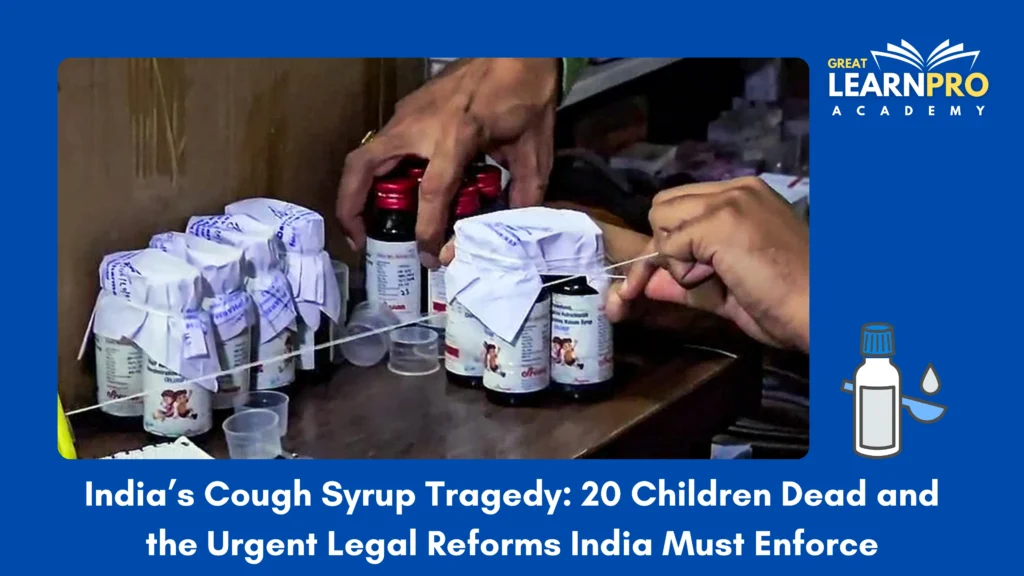In a heartbreaking incident that has once again shaken India’s faith in its pharmaceutical regulatory framework, 20 children have died after consuming contaminated cough syrup. The syrup, reportedly containing high levels of diethylene glycol (DEG) a toxic chemical used as an industrial solvent led to fatal kidney and multi-organ failures among the victims. This is not the first time India has witnessed such a tragedy. Over the decades, several similar incidents have occurred, each exposing deep flaws in the monitoring, quality control, and enforcement systems within the pharmaceutical industry.
This tragedy raises urgent questions about how such a failure could recur despite repeated warnings, and what laws exist to prevent and punish such negligence.

A Recurring Nightmare: Pattern of Negligence
The present incident echoes past disasters, such as the 1998 Delhi tragedy, 2020 Jammu case, and more recently, the Gambia cough syrup deaths in 2022, where Indian-made syrups were linked to the deaths of dozens of children abroad. Investigations in these cases revealed the presence of toxic chemicals such as ethylene glycol and diethylene glycol, which are highly poisonous when ingested. These substances are often mistakenly or negligently used instead of pharmaceutical-grade glycerin or propylene glycol ingredients used to give syrups their smooth texture.
What is most alarming is that the same type of chemical contamination has recurred for nearly a century, despite medical and legal knowledge of its dangers. This exposes a chronic failure of pharmaceutical quality control, supply-chain integrity, and regulatory oversight.
The Legal Framework Governing Drug Safety in India
India’s drug regulation system primarily rests on the Drugs and Cosmetics Act, 1940, and the Drugs and Cosmetics Rules, 1945. These laws are intended to ensure that every drug sold in India meets prescribed standards of quality, safety, and efficacy. The Central Drugs Standard Control Organisation (CDSCO) acts as the apex regulatory authority, while state drug controllers are responsible for enforcing standards at the manufacturing and retail levels.
Under Section 18 of the Drugs and Cosmetics Act, no person is allowed to manufacture, sell, or distribute a drug that is not of standard quality, or that is misbranded, adulterated, or spurious. Violation of these provisions attracts severe penalties under Sections 27 and 27A, including imprisonment ranging from 10 years to life for causing death or grievous harm.
Despite such stringent provisions on paper, the frequent recurrence of such incidents reveals gaps in enforcement. Many small or unlicensed pharmaceutical units operate with minimal oversight, especially in states with limited regulatory manpower. Routine inspections are rare, and testing laboratories often face backlogs or lack modern equipment to detect impurities.
The Role of Quality Control and Supply Chain Oversight
A crucial weakness lies in the procurement of raw materials. Many small manufacturers purchase ingredients like glycerin from unverified sources, often based on price rather than quality assurance. Contaminated industrial-grade chemicals sometimes enter the pharmaceutical supply chain due to lax documentation and weak vendor verification systems.
The Good Manufacturing Practices (GMP) standards, prescribed under Schedule M of the Drugs and Cosmetics Rules, mandate that every manufacturer must ensure raw materials are tested and certified for purity before use. However, in practice, smaller firms often skip these tests or forge compliance certificates. Periodic audits by state drug inspectors are either irregular or insufficiently rigorous, allowing non-compliant manufacturers to operate unchecked.
Accountability and Punishment: What the Law Says
Under Section 27(a) of the Drugs and Cosmetics Act, if the use of any drug results in death or serious injury, the manufacturer and those responsible can be charged with culpable homicide under Section 304 of the Indian Penal Code (IPC), in addition to penalties under the Drugs Act. The government can also suspend or cancel the company’s manufacturing license.
In the aftermath of this tragedy, police and regulatory authorities have launched investigations to trace the supply chain of the contaminated syrup, seize remaining stock, and test samples. If negligence is proven, the company’s directors, quality assurance officers, and procurement heads can be held criminally liable.
However, past experience suggests that convictions in such cases are rare. The judicial process is slow, and the pharmaceutical lobby often exerts influence to dilute accountability. Moreover, regulatory penalties such as license suspension are temporary and rarely lead to systemic change.
International Repercussions and Image Crisis
Incidents like this not only cause domestic outrage but also affect India’s global reputation as the “pharmacy of the world.” The World Health Organization (WHO) has previously issued alerts against certain Indian-made syrups exported to other countries, citing contamination. Such warnings undermine trust in Indian generics and can have severe economic consequences, especially for a country that exports over $25 billion worth of pharmaceuticals annually.
The Way Forward: Reforming the System
To prevent such tragedies from recurring, India must strengthen both its regulatory framework and enforcement mechanisms. Some key reforms include:
- Mandatory Batch Testing before export and domestic sale, especially for liquid formulations consumed by children.
- Centralized Ingredient Tracking System to trace every batch of raw materials back to its source.
- Enhanced Penalties for manufacturers who knowingly violate safety standards, including permanent cancellation of licenses.
- Whistleblower Protection Mechanisms to encourage insiders to report unsafe practices without fear of retaliation.
- Strengthening Forensic Testing Laboratories across states to ensure faster and more accurate detection of adulteration.
Conclusion
The deaths of these 20 children are not isolated accidents but the result of systemic negligence a reflection of how profit and lax oversight can cost innocent lives. India’s drug safety laws are robust on paper but weak in practice. Unless the enforcement machinery becomes proactive, transparent, and technology-driven, tragedies like this will continue to haunt the nation. The lives lost must serve as a grim reminder that in healthcare, negligence is not a mistake it is a crime.
Sources:
- https://www.reuters.com/business/healthcare-pharmaceuticals/india-declares-three-cough-syrups-toxic-after-child-deaths-2025-10-09/?utm_
- https://m.economictimes.com/news/india/cough-syrup-deaths-sresan-pharma-owner-ranganathan-sent-to-10-day-police-custody/articleshow/124454032.cms?utm_
- https://timesofindia.indiatimes.com/india/government-tightens-drug-quality-checks-after-cough-syrup-deaths/articleshow/124392207.cms?utm_
- https://www.indiatoday.in/amp/india/law-news/story/cough-syrup-child-deaths-supreme-court-plea-inquiry-nationwide-testing-2798996-2025-10-07?utm_
More Current affairs: https://learnproacademy.in/updates/
